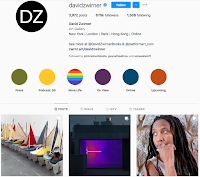Phygital is an evolving concept. Some might say the evolution that is creating the phygital art market was begun from the pandemic—a desire to make lemonade from the abundance of lemons in a shut down world-wide economy.
But really it's a moment of shifting the art buying process from what is comfortable for Baby Boomers to how Millennials would like to shop—for everything—online. This issue was articulated in the New York Times article by Scott Reyburn dated June 8, 2020: "As the Art World Goes Online, a Generation Gap Opens."
And yet David Zwirner was ahead of the shift and debuted Platform: New York, which was announced in a different NYTimes article written more than two months before by Robin Pogrebin dated March 27, 2020: "In Time of Quarantine, Zwirner Shares Online Platform With Smaller Galleries."How did he do that?
He had been listening to his kids. From the above linked NYTimes article:
... Mr. Zwirner, add[ed] that the idea came from his son and daughter—Lucas and Marlene—who work at the gallery, along with other younger members of his staff: Alec Smyth, Thor Shannon and Cristina Vere Nicoll.
I believe that I got on the David Zwirner Gallery email list when I checked out his gallery a few years back because it was an example of a gallery using Art Storefronts—though I can't substantiate this with evidence as Art Storefronts has continued to evolve their niche market and website, so he's not there anymore. Art Storefronts is on the cutting edge of creating a new wave of professional artrepreneurs that can sell their art work directly to art buyers, cutting out the middleman: galleries and art dealers.
From the outside, this dichotomy—represented artists versus self-promoting artists—may seem an inherent conflict of interest. But it's how artists—in all the mediums that they create in: visual art, performance art, film, writing, poetry, photography—continue the process of redefining what art is. A very famous example is photographer Alfred Stieglitz showing Modernist artists—including his wife Georgia O'Keeffe—at his galleries: 291, The Intimate Gallery, and An American Place.
As an artist and a gallerist, I have been watching Art Storefronts as they develop. I checked them out as a bolt-on for my then gallery website, but as I have continued my own evolution I would like to use them for selling my own work and possibly for selling the work of a select few artists I still informally represent.
I have been getting David Zwirner Gallery emails for
awhile. As the concept for The Living Room blog was slowing developing
in my mind as the pandemic dragged on—then cemented with the NYTimes
article I mentioned in my introductory post—I started opening the David
Zwirner emails, all interesting, but nothing grabbed me like the Ray
Johnson email from April 8th. I decided that Ray Johnson would be June's The Living Room post.
Then this article—Zwirner May Disrupt Art Gallery Model With Click-to-Buy Business—came out in mid-May, also written by Robin Pogrebin as a follow up to the original article from more than a year ago. Now Platform isn't just a response to the pandemic; it's a new business model. Hence, why reviewing the phygital art experience will become the apex of this changing art market in the competition for eyes (between galleries and self-promoting artists).
The article highlighted a fear that Platform would just be poaching hot new artists from smaller galleries in the collaboration of partnering with Zwirner on Platform, an issue raised by Larry Gagosian.
“I wouldn’t be interested in doing something like that — it’s a little bit of a wolf in sheep’s clothing,” said the dealer Larry Gagosian. “My advice to smaller galleries would be preserve your own identity and brand — even if you can’t do it at the level of a large gallery, work within your means and don’t hand over your artists and client lists to somebody who might take advantage of it at some point.”
Then Pogrebin expanded on this issue in the next paragraph.
Skeptics will say that Zwirner is just trying to garner publicity and generate good will with a paternalistic, Robin Hood move that ultimately gives his own gallery 20 percent of every sale on Platform. And some in the art world worry that Platform is merely a farm team for Zwirner — a way to develop emerging artists, woo them from smaller galleries, and harvest information about those galleries’ clientele.
Gagosian's comment and the elaboration on skeptics' thinking are both a bit disingenuous as the issue of poaching has been happening as long as there have been galleries. Again the symbiotic relationship between smaller independent galleries showing new artists and the big dogs selling masters and newly minted artists to the canon... Well, this is the game: that the traditional galleries need to be fed more buyers (consumers), more artists (product), and keep up with the latest developments on a quickly changing art scene. While rubbing shoulders with corporate galleries, the smaller independent galleries will grow their own credibility and reputation on the way to possibly become more financially successful.
Isn't that capitalism?
